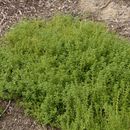Comments
(
Inglês
)
fornecido por eFloras
This species has gone under the misapplied name Chenopodium carinatum R. Brown (now 9. Dysphania carinata).
- licença
- cc-by-nc-sa-3.0
- direitos autorais
- Missouri Botanical Garden, 4344 Shaw Boulevard, St. Louis, MO, 63110 USA
Description
(
Inglês
)
fornecido por eFloras
Stems prostrate to suberect, much-branched to ± simple, 0.1-4.5 dm, pilose with segmented (uniseriate) hairs and sessile or stipitate glandular hairs. Leaves malodorous; petiole 0.3-1.5 cm; blade narrowly to broadly elliptic to ovate, 0.5-2.7 × 0.3-1.5 cm, somewhat reduced in inflorescence, base cuneate, apex obtuse, glandular-pilose. Inflorescences lateral cymes or glomerules; glomerules subglobose, 1.2-2.5 mm diam.; bracts leaflike, 3-4.5 mm, elliptic, margins crenate-dentate, apex obtuse. Flowers: perianth segments 5, distinct nearly to base, distinct portions narrowly elliptic to narrowly oblong, 0.6-0.7 × 0.2-0.3 mm, apex acute, normally rounded abaxially, usually glandular-pilosulose, becoming crustaceous and white in fruit; stamens absent or 1; stigmas 2. Achenes ovoid; pericarp adherent, membranaceous, slightly rugose. Seeds reddish brown, ovoid, 0.5-0.7 × 0.5-0.6 mm, margins keeled or rounded; seed coat smooth.
- licença
- cc-by-nc-sa-3.0
- direitos autorais
- Missouri Botanical Garden, 4344 Shaw Boulevard, St. Louis, MO, 63110 USA
Distribution
(
Inglês
)
fornecido por eFloras
introduced; Ark., Calif., Conn., D.C., Fla., Ga., Ill., Kans., Ky., La., Mass., Mo., Nev., N.J., N.Y., Ohio, Okla., Oreg., Pa., R.I., S.C., Tenn., Tex., Va., Wash., Wis.; Australia; introduced in subtropical and warm-temperate regions.
- licença
- cc-by-nc-sa-3.0
- direitos autorais
- Missouri Botanical Garden, 4344 Shaw Boulevard, St. Louis, MO, 63110 USA
Flowering/Fruiting
(
Inglês
)
fornecido por eFloras
Fruiting late summer-fall.
- licença
- cc-by-nc-sa-3.0
- direitos autorais
- Missouri Botanical Garden, 4344 Shaw Boulevard, St. Louis, MO, 63110 USA
Habitat
(
Inglês
)
fornecido por eFloras
Waste areas on rocky, sandy, or gravelly soils, sidewalks, rare in moist soils in forests; 0-1200m.
- licença
- cc-by-nc-sa-3.0
- direitos autorais
- Missouri Botanical Garden, 4344 Shaw Boulevard, St. Louis, MO, 63110 USA
Synonym
(
Inglês
)
fornecido por eFloras
Chenopodium pumilio R. Brown, Prodr., 407. 1810; Teloxys pumilio (R. Brown) W. A. Weber
- licença
- cc-by-nc-sa-3.0
- direitos autorais
- Missouri Botanical Garden, 4344 Shaw Boulevard, St. Louis, MO, 63110 USA
Dysphania pumilio
(
Inglês
)
fornecido por wikipedia EN
Dysphania pumilio is a species of flowering plant in the family Chenopodioideae known by the common name clammy goosefoot.
It is native to Australia, but it can be found in other parts of the world as an introduced species, often growing in disturbed and waste areas such as roadsides and lots. It is known from many parts of North America and Europe, and it was recently spotted in Iran for the first time, in the Māzandarān Province.[1] It is thought to have first arrived in Europe with imports of wool from Australia.[1] This is a very aromatic annual herb growing erect, sticky, glandular stems up to about 25 centimeters tall. The leaves are alternately arranged, up to 2 centimeters long, lance-shaped to oval and edged with bumpy lobes. The surface of the leaf is coated in white sticky glands and sparse hairs. The inflorescence is a spherical cluster of densely packed tiny green flowers located in the leaf axils. Each flower is pebbly with glands and covers the developing fruit.
References

- licença
- cc-by-sa-3.0
- direitos autorais
- Wikipedia authors and editors
Dysphania pumilio: Brief Summary
(
Inglês
)
fornecido por wikipedia EN
Dysphania pumilio is a species of flowering plant in the family Chenopodioideae known by the common name clammy goosefoot.
It is native to Australia, but it can be found in other parts of the world as an introduced species, often growing in disturbed and waste areas such as roadsides and lots. It is known from many parts of North America and Europe, and it was recently spotted in Iran for the first time, in the Māzandarān Province. It is thought to have first arrived in Europe with imports of wool from Australia. This is a very aromatic annual herb growing erect, sticky, glandular stems up to about 25 centimeters tall. The leaves are alternately arranged, up to 2 centimeters long, lance-shaped to oval and edged with bumpy lobes. The surface of the leaf is coated in white sticky glands and sparse hairs. The inflorescence is a spherical cluster of densely packed tiny green flowers located in the leaf axils. Each flower is pebbly with glands and covers the developing fruit.
- licença
- cc-by-sa-3.0
- direitos autorais
- Wikipedia authors and editors

